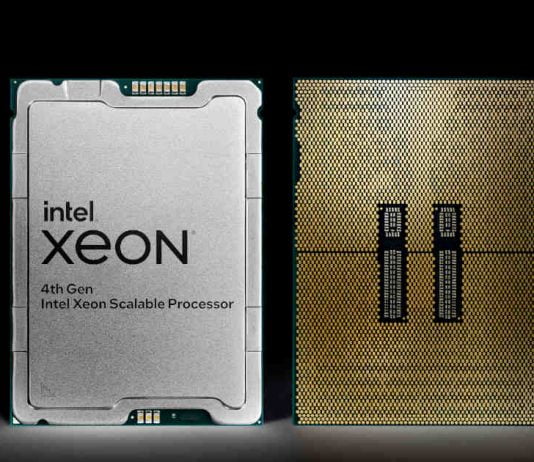Intel has officially unveiled its 4th Gen Xeon Scalable Sapphire Rapids CPUs and Ponte Vecchio Max series GPUs for data centres. This new portfolio of 52 CPUs will compete with AMD’s EPYC Genoa line, which launched last year. Intel will also launch the final product line of its Optane persistent memory DIMMs.
AMD’s chips currently have up to 96 cores per chip, whereas Intel’s Sapphire Rapids chips have up to 60 cores, which is 50% more than the 3rd Gen 40 cores Ice Lake Xeon. Intel claims this will improve the overall computing performance by 53% compared to the previous generation chip, but no direct comparison was made with AMD chips at launch.
Sapphire Rapids is taking a big step forward with new acceleration technology. These dedicated accelerator regions are designed to significantly improve performance for tasks requiring separate accelerators, such as compression, encryption, data movement, and data analytics.
AMD leads in core count, but Genoa processors don’t have the same acceleration characteristics. With the new accelerator, Intel claims to improve 2.9x average performance per watt over the previous generation model. It also promises a 10x improvement in AI training and inference and a 3x improvement in data analytics workloads.
Built using the Intel 7 process, Intel Sapphire Rapids also supports new connectivity technologies such as PCIe 5.0, DDR5 memory, and CXL 1.1 interfaces (Type 1 and Type 2 devices). The new processors also support AVX-512, Deep Leaning Boost (DLBoost), and new Advanced Matrix Extensions (AMX) instructions that use a new two-dimensional register set called tiles to improve the efficiency of AI work.
The new processors are divided into “performance” and “mainstream” dual-socket chips for general-purpose models and speciality models for systems such as liquid cooling, single-socket, networking, cloud, HPC and storage/HCI. As a result, there are specialized chips for almost every workload, but with a complex lineup.
Sapphire Rapids chips have several active accelerator devices and different numbers of the accelerator “devices” available, resulting in different performances. A new pay-as-you-go mechanism called Intel On-Demand lets you enable acceleration later.
Traditionally, Intel’s 4th Gen Xeon Scalable platform supports 1, 2, 4 and 8 socket configurations, while rival AMD’s Genoa can only scale to 2 sockets. However, AMD offers more PCIe connectivity options with up to 128 lanes of PCIe 5.0 connectivity compared to Sapphire Rapids’ 80 lanes of PCIe 5.0 connectivity. Sapphire Rapids supports up to 1.5 TB of DDR5-4800 memory with 8 channels per socket, while AMD’s Genoa supports up to 6 TB of DDR5-4800 memory with 12 channels per socket.
Despite limitations with PCIe connectivity, Intel’s Sapphire Rapids processors offer a variety of features designed to boost performance in specific workloads. For example, new acceleration technologies are specifically designed to improve the performance of tasks such as compression, encryption, data movement, and data analysis. This can greatly benefit businesses that rely on these types of workloads, as it can lead to significant performance improvements and cost savings.
Another benefit of Sapphire Rapids is support for new connectivity technologies such as PCIe 5.0, DDR5 memory and CXL 1.1 interfaces. These technologies are designed to improve data transfer speeds and overall system performance, making the processors well-suited for demanding workloads such as high-performance computing, artificial intelligence, and machine learning.
Sapphire Rapids also has new Advanced Matrix Extensions (AMX) instructions to make your AI work more efficiently. A new set of two-dimensional records called tiles can dramatically improve load performance. AMX implementations are primarily used to improve the performance of AI inference and training operations.
In conclusion, Intel Sapphire Rapids processors offer a range of features designed to improve performance on specific workloads. New acceleration technologies, support for new connectivity technologies, and AMX instructions greatly benefit businesses that rely on these workloads. Furthermore, the processor’s scalability and customization make it suitable for a wide range of business requirements. AMD leads in core count, but Intel’s technology can provide better performance for certain workloads.


